-2024届高三英语谓语动词的时态语态和主谓一致课件(共60张PPT)
文档属性
| 名称 | -2024届高三英语谓语动词的时态语态和主谓一致课件(共60张PPT) |  | |
| 格式 | pptx | ||
| 文件大小 | 558.2KB | ||
| 资源类型 | 教案 | ||
| 版本资源 | 通用版 | ||
| 科目 | 英语 | ||
| 更新时间 | 2023-12-21 10:52:18 | ||
图片预览


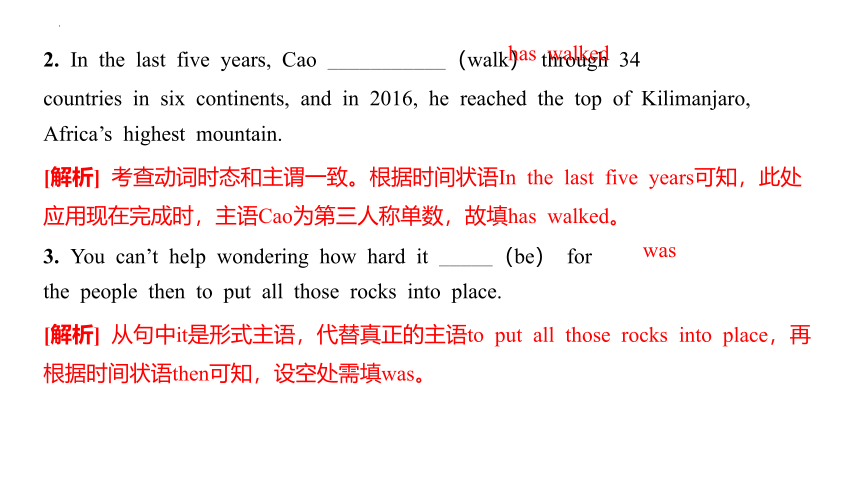
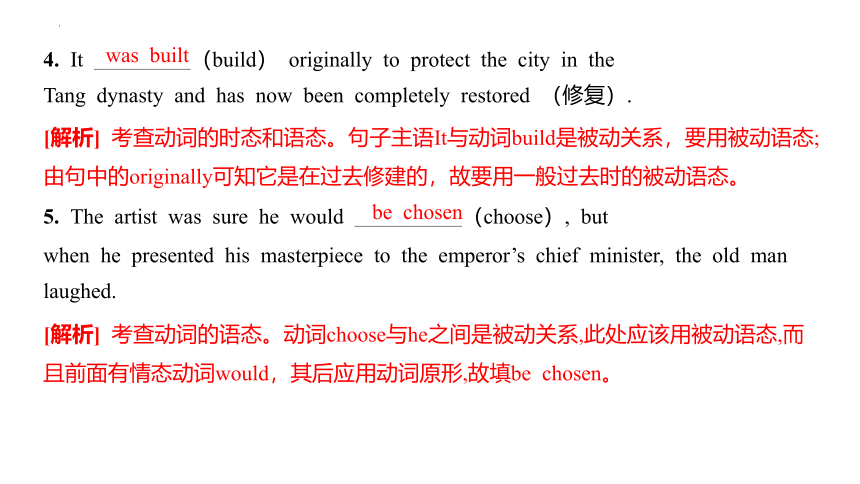
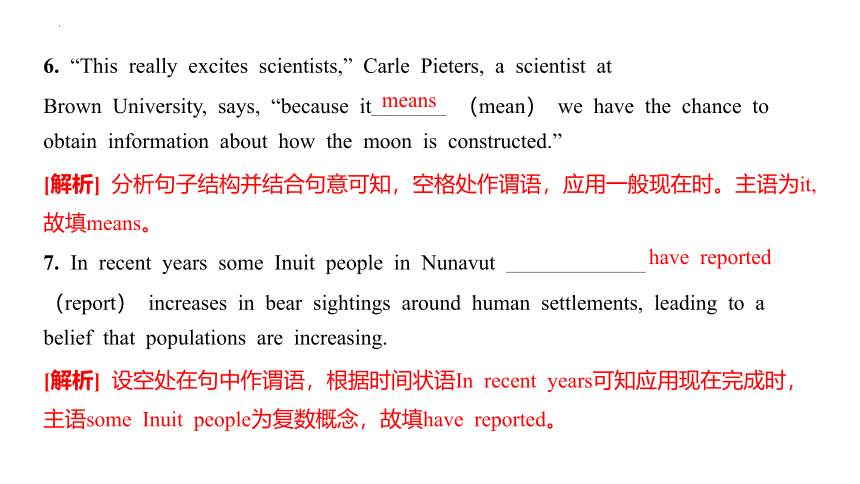
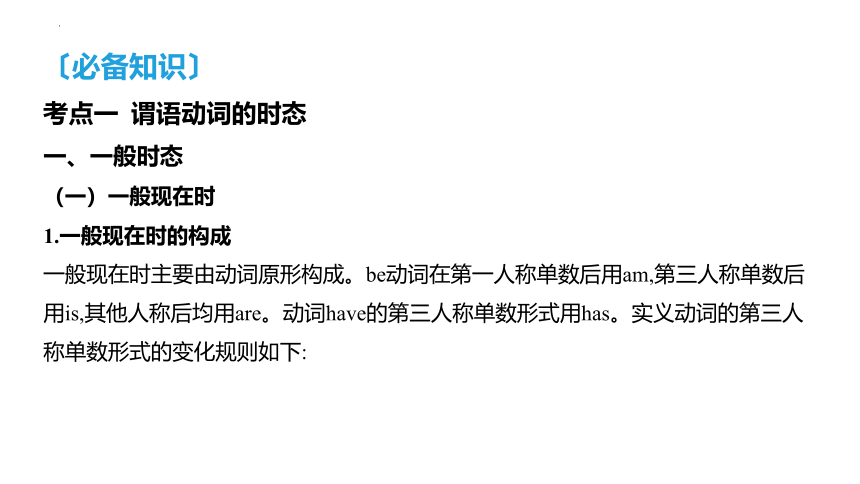

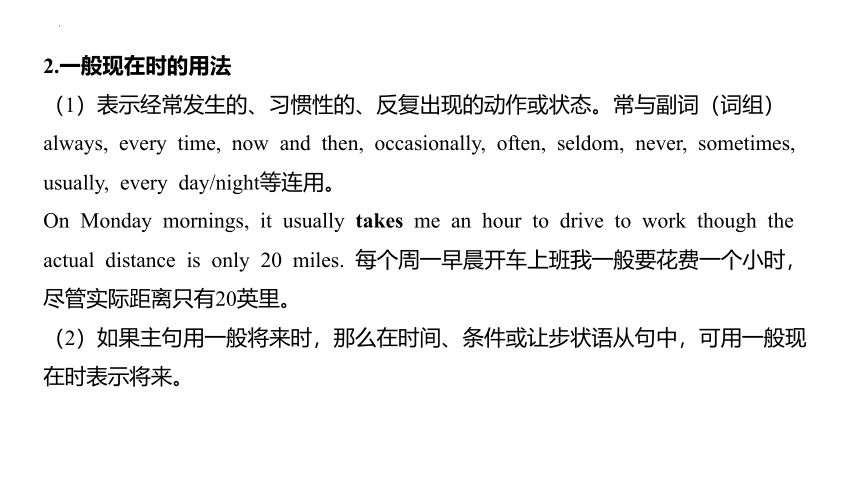
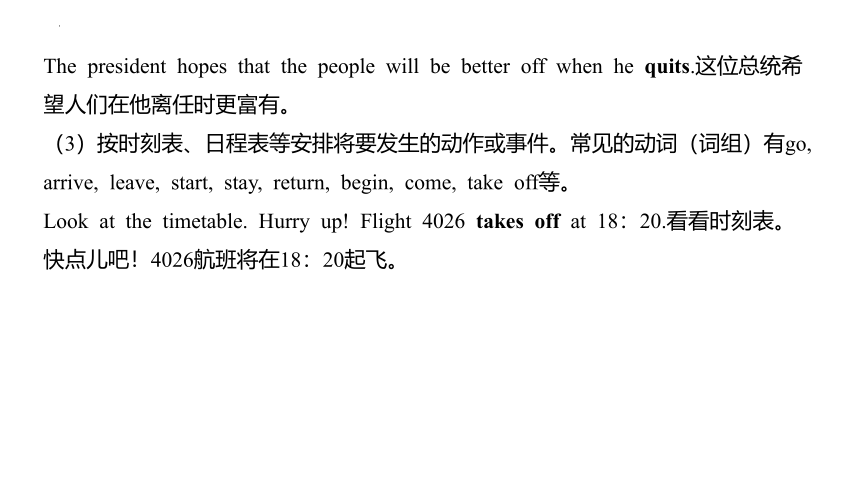
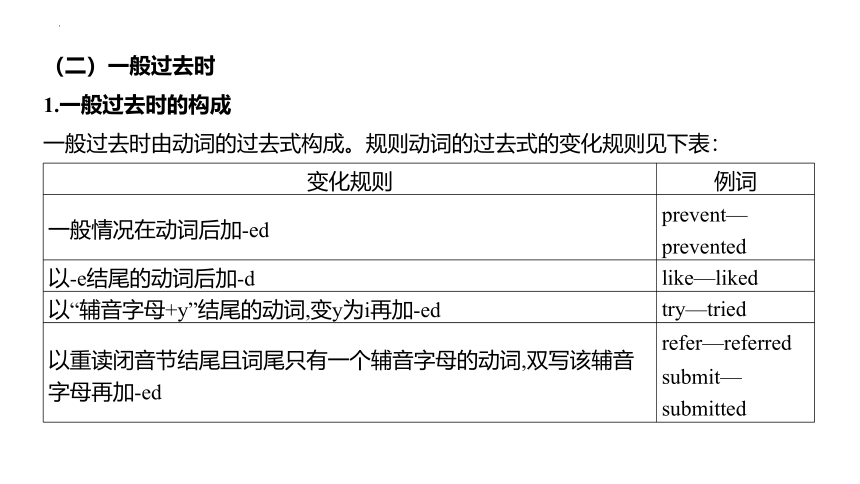

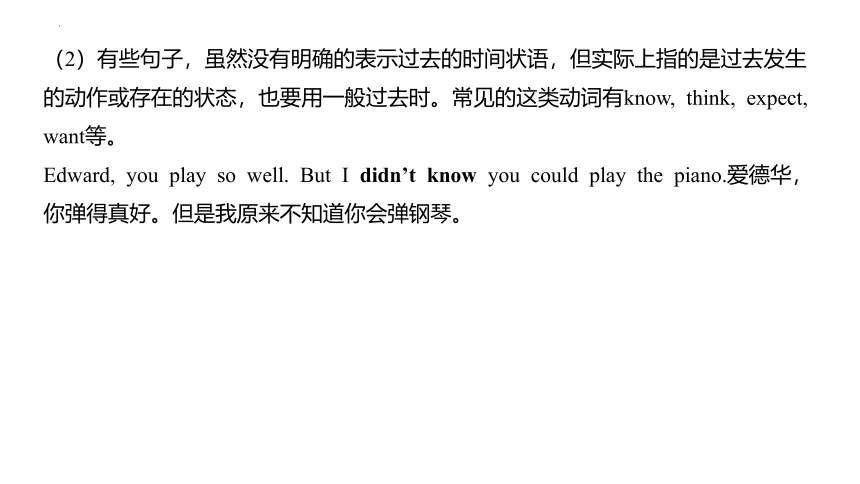
文档简介
(共60张PPT)
谓语动词的时态、语态和主谓一致
1. The plan will extend protection to a significant number of
areas that ______(be) previously unprotected...
were
[解析] 考查动词时态和主谓一致。that引导限制性定语从句,先行词areas为复数名词,从句中的谓语动词应用复数形式;根据“previously (之前地)”可知,从句应用一般过去时,故填were。
2. In the last five years, Cao ___________(walk) through 34
countries in six continents, and in 2016, he reached the top of Kilimanjaro,
Africa’s highest mountain.
has walked
[解析] 考查动词时态和主谓一致。根据时间状语In the last five years可知,此处应用现在完成时,主语Cao为第三人称单数,故填has walked。
3. You can’t help wondering how hard it _____(be) for
the people then to put all those rocks into place.
was
[解析] 从句中it是形式主语,代替真正的主语to put all those rocks into place,再根据时间状语then可知,设空处需填was。
4. It _________(build) originally to protect the city in the
Tang dynasty and has now been completely restored (修复).
was built
[解析] 考查动词的时态和语态。句子主语It与动词build是被动关系,要用被动语态;由句中的originally可知它是在过去修建的,故要用一般过去时的被动语态。
5. The artist was sure he would __________(choose), but
when he presented his masterpiece to the emperor’s chief minister, the old man
laughed.
be chosen
[解析] 考查动词的语态。动词choose与he之间是被动关系,此处应该用被动语态,而且前面有情态动词would,其后应用动词原形,故填be chosen。
6. “This really excites scientists,” Carle Pieters, a scientist at
Brown University, says, “because it_______ (mean) we have the chance to
obtain information about how the moon is constructed.”
means
[解析] 分析句子结构并结合句意可知,空格处作谓语,应用一般现在时。主语为it,故填means。
7. In recent years some Inuit people in Nunavut _____________
(report) increases in bear sightings around human settlements, leading to a
belief that populations are increasing.
have reported
[解析] 设空处在句中作谓语,根据时间状语In recent years可知应用现在完成时,主语some Inuit people为复数概念,故填have reported。
〔必备知识〕
考点一 谓语动词的时态
一、一般时态
(一)一般现在时
1.一般现在时的构成
一般现在时主要由动词原形构成。be动词在第一人称单数后用am,第三人称单数后用is,其他人称后均用are。动词have的第三人称单数形式用has。实义动词的第三人称单数形式的变化规则如下:
变化规则 例词
一般情况直接加-s hate—hates
结尾为-s,-x,-sh,-ch或-o,在词尾加-es discuss—discusses
wash—washes fix—fixes
teach—teaches go—goes
结尾为“辅音字母+y”,变y为i再加-es carry—carries study—studies
2.一般现在时的用法
(1)表示经常发生的、习惯性的、反复出现的动作或状态。常与副词(词组)always, every time, now and then, occasionally, often, seldom, never, sometimes, usually, every day/night等连用。
On Monday mornings, it usually takes me an hour to drive to work though the actual distance is only 20 miles. 每个周一早晨开车上班我一般要花费一个小时,尽管实际距离只有20英里。
(2)如果主句用一般将来时,那么在时间、条件或让步状语从句中,可用一般现在时表示将来。
The president hopes that the people will be better off when he quits.这位总统希望人们在他离任时更富有。
(3)按时刻表、日程表等安排将要发生的动作或事件。常见的动词(词组)有go, arrive, leave, start, stay, return, begin, come, take off等。
Look at the timetable. Hurry up! Flight 4026 takes off at 18:20.看看时刻表。快点儿吧!4026航班将在18:20起飞。
(二)一般过去时
1.一般过去时的构成
一般过去时由动词的过去式构成。规则动词的过去式的变化规则见下表:
变化规则 例词
一般情况在动词后加-ed prevent—
prevented
以-e结尾的动词后加-d like—liked
以“辅音字母+y”结尾的动词,变y为i再加-ed try—tried
以重读闭音节结尾且词尾只有一个辅音字母的动词,双写该辅音 字母再加-ed refer—referred
submit—
submitted
2.一般过去时的用法
(1)表示过去一段时间内经常性或习惯性的动作。常与often, usually, seldom 等表示频率的副词连用。还可以表示在过去某一时间所发生的动作或存在的状态,与现在没有关系,常与yesterday, the other day, last week, the day before yesterday等表示过去的时间状语连用。
A few months after he had arrived in China, Mr. Smith fell in love with the people and culture there.史密斯先生到中国几个月后就喜欢上了那里的人和文化。
(2)有些句子,虽然没有明确的表示过去的时间状语,但实际上指的是过去发生的动作或存在的状态,也要用一般过去时。常见的这类动词有know, think, expect, want等。
Edward, you play so well. But I didn’t know you could play the piano.爱德华,你弹得真好。但是我原来不知道你会弹钢琴。
(三)一般将来时
1.一般将来时的构成
一般将来时由“shall/will+动词原形”构成。
2.一般将来时的用法
(1)表示从现在看来将来要发生的动作或存在的状态,常与表示将来的时间状语tomorrow, next year, in+一段时间等连用。
The students have been working hard on their lessons and they will be rewarded with success in the future.学生们一直在刻苦学习功课,他们将来会得到成功的回报。
(2)“will+动词原形”还可以表示说话时临时做出的决定。
—What time is it
——几点了?
—I have no idea. But just a minute, I will check it for you.
——我不知道。但是你稍等一下,我给你查查。
3.其他表示“将来”的结构及用法
(1)“be going to+动词原形”表示按计划打算要做某事或某种迹象预示着要发生某事。
Look! Dark clouds are gathering. It is going to rain soon, I think.
瞧!乌云正在聚集。 我想快要下雨了。
(2)“be to+动词原形”表示按计划或安排即将发生的动作;也可表示职责、义务、意图、禁止等。
You are to hand in your papers by 10 o’clock.
你们必须在10点前上交试卷。
(3)“be about to+动词原形”表示正要或即将要做某事,该结构不与表示具体时间的状语连用。
The train is about to start.火车就要开了。
二、进行时态
(一)进行时的构成
现在进行时由“am/is/are+现在分词”构成;过去进行时由“was/were+现在分词”构成;将来进行时由“will/shall+be+现在分词”构成。现在分词的变化规则如下表:
变化规则 例词
一般情况在词尾直接加-ing ask—asking
以不发音的e结尾的动词,去e再加-ing write—writing
face—facing
以重读闭音节结尾,且末尾只有一个辅音字母的动词,双写 该辅音字母再加-ing cut—cutting
begin—beginning
swim—swimming
以-ie结尾的动词,变-ie为y再加-ing lie—lying
die—dying
(二)进行时的用法
1.现在进行时
(1)表示说话时正在进行或现阶段正在进行的动作,虽然此时此刻该动作不一定正在进行。
Today we are facing a strange new world and we are all wondering what we are going to do.我们今天面对的是一个陌生的新世界,并且我们都想知道我们将要做什么。
(2)表示按计划或安排即将发生的动作,常见的动词有go, come, leave, start, arrive, return等。
Keep calm, please. I am arriving. 请保持镇静,我马上就到。
2.过去进行时
(1)表示过去某一时刻或某一段时间内正在进行的动作,常与表示过去的时间状语从句以及at that time, at that moment, at this time yesterday, at ten o’clock yesterday等连用。
He was writing a book last year, but I don’t know if he has finished it. 他去年在写一本书,但我不知道他是否已经完成了。
(2)表示一个过去的动作正在进行时,这时另一个过去的动作发生了,常与并列连词when连用。
Jack was working in the lab when the power cut occurred. 杰克正在实验室里工作,这时突然断电了。
3.将来进行时
表示将来某一时刻或某一时段正在发生或进行的动作,常与一些标志性的时间状语连用,如this time tomorrow, at that time, from 1:30 to 4:30 tomorrow等。
Jane can’t attend the meeting at 3 o’clock this afternoon because she will be teaching a class at that time.简不能参加今天下午三点的会议,因为她那时有一堂课。
三、完成时态
(一)完成时的构成
现在完成时由“have/has+过去分词”构成;过去完成时由“had+过去分词”构成。
(二)完成时的用法
1.现在完成时
(1)表示说话时已经完成的动作,但这个动作对现在仍有影响。常与already, just, yet等时间状语连用。
The manager has just left. If only you had come a moment earlier.经理刚走,你要是能早来一会儿就好了。
(2)表示动作发生在过去,但一直延续至今(可能还要延续下去)。常与since+时间点,for+时间段等时间状语连用。
His first novel has received good reviews since it came out last month.他的第一部小说自上个月出版以来获得了好评。
(3)在条件、时间等状语从句中,可用现在完成时表示将来某时间前已完成的动作。
I’ll give my opinion when I have read the book through. 我读完了这本书就会告诉你我的意见。
2.过去完成时
(1)表示在过去某一时间或某一动作之前完成的动作,即“过去的过去”。句中一般有明确的表示“过去的过去”的时间状语(从句),但在语法填空题中很多时候需要通过上下文来判断。
When walking down the street, I came across David, whom I hadn’t seen for years.当沿街散步的时候,我遇见了多年未见的戴维。
(2)表示从过去某一时间开始,一直延续到过去的另一时间的动作或状态,常用的时间状语有before, by that time, by the end of, by the time等。
By the end of June they had treated over 10,000 patients.到六月底他们已治疗了一万多名病人。
(3)表示“希望、打算、认为”的动词(如hope, want, expect, think, mean, wish, plan, intend)用过去完成时表示过去本打算实现而未实现的愿望或计划。
I had hoped to send Peter a gift to congratulate him on his marriage, but I couldn’t manage it.我本希望送给彼得一份礼物以祝贺他结婚,但我没能做到。
3.常使用完成时的句型
(1)This/It/That is the+序数词+time+that sb. has/have done sth.
This/It/That was the+序数词+time+that sb. had done sth.这/那是某人第几次做某事。
(2)It/This is/was the+最高级+名词+(that)定语从句,从句中的谓语动词用现在/过去完成时。
(3)It is/has been+一段时间+since sb. did sth.
It was/had been+一段时间+since sb. had done sth.自从某人做某事以来多久了。
(4)在句型Hardly/Scarcely...when.../No sooner...than...中,主句用过去完成时,从句用一般过去时。
Hardly had I got home when the rain poured down.我刚到家,雨就倾盆而下。
四、过去将来时
1.过去将来时的构成
过去将来时由“would+动词原形”构成。
2.过去将来时的用法
(1)表示从过去的某一时间来看将来(仍然是过去时间)要发生的动作或呈现的状态。
He said that he would never return. 他说他决不回来。
(2)表示过去的某种习惯性行为。
Whenever we had trouble, he would come to help us. 每当我们遇到困难时,他总会来帮助我们。
(3)表示强烈意愿。
I love my dog and I would never part from him. 我爱我的狗,决不愿和它分离。
五、现在完成进行时
1.现在完成进行时的构成
现在完成进行时由“have/has+been+v.-ing”构成。
2.现在完成进行时的用法
(1)常用来表示动作开始于过去某个时间,一直持续到现在并且可能会继续进行下去。
(2020天津卷)—You are a great swimmer.
——你游泳很棒。
—Thanks. It’s because I have been practising a lot these days.
——谢谢。这是因为这些天我一直在练习。
I’m very tired. I have been correcting the students’ papers all the morning.我很累。我整个上午都在批改学生的试卷。
(2)表示到目前为止的一段时间里在反复进行的动作。
I have been calling him many times this morning, but there’s no answer.今天早上我给他打了很多次电话,但都没有回应。
易错提示
现在完成时与现在完成进行时的区别:
现在完成时表示过去开始的一个动作到目前为止已经完成,体现动作的结果;现在完成进行时表示过去开始的一个动作到目前为止仍在进行,甚至仍将继续。
I’ve read Journey to the West.
我已经读过《西游记》了。(已经完成)
I have been reading Journey to the West these days.
这些天我一直在读《西游记》。(仍在进行甚至仍将继续)
考点特训
1. I took out a pan from the bottom drawer
of the stove, and carefully _______(place) it on the front burner.
placed
[解析] 由took可知,句子描述过去的事情,应用一般过去时,故填placed。
2. Beijing is such a big stage and I have
missed out on many of the big events that ___________(take) place in the
past few years.
have taken
[解析] 由in the past few years可知应用现在完成时,从句的主语是关系代词that,指代先行词big events,且take place(发生)无被动语态,故填have taken。
3. Shi Guangyin, an eco-warrior from Shaanxi Province,
__________________________(battle) against desertification for about 40 years.
has been battling/has battled
[解析] 根据“for about 40 years”可知,句子应用现在完成时或现在完成进行时,句子的主语Shi Guangyin为第三人称单数,故填has been battling或has battled。
4. The unmanned Chang’e-4 probe (探测器)—the name was
inspired by an ancient Chinese moon goddess—________(touch) down last
week in the South Pole-Aitken basin.
touched
[解析] 根据时间状语last week可知,设空处动作发生在过去,要用一般过去时。
5. When he asked the villagers on the banks of the river where he
could find the legendary (传奇的) artist, they smiled and ________(point) down
the river.
pointed
[解析] and连接两个并列的谓语动词,空处的动词形式应与smiled一致,故填pointed。
6. By about 6000 BC, people
________________________________________________________________________
(discover) the best crops to grow and animals to raise.
had discovered 根据时间状语By about 6000 BC可知,设空处应使用过去完成时。
7. I don’t see any reason to give up work. I love coming here and seeing my family
and all the friends I
___________________________________________________________________________
(make) over the years.
have made 根据后面的时间状语over the years可知应用现在完成时,故填have made。
8. Father ________(leave) for London on business upon my arrival, so I didn’t
see him.
had left
[解析] 根据语境可知,设空处动作应该发生在didn’t see之前,表示“过去的过去”,应该用过去完成时。故填had left。
9. The Chinese Ministry of Agriculture finds that between 2005—when the
government _______(start) a soil-testing program that gives specific fertilizer
recommendations to farmers—and 2011, fertilizer use dropped by 7.7 million
tons.
started
[解析] 句意:中国农业部发现在2005年和2011年之间,化肥的使用减少了770万吨。2005年政府启动了土壤检测项目,它给了农民具体的化肥使用建议。关系副词when相当于in 2005,由此可知此处使用一般过去时。
10. A representative who _________(see) his performance before thought he
could replace another star who intended to leave.
had seen
[解析] 设空处在定语从句中作谓语,根据主句谓语动词thought以及第一个定语从句中的时间状语before可知,设空处动作发生在“过去的过去”,故设空处所在从句用过去完成时。
考点二 谓语动词的语态
一、被动语态的构成和用法
1.被动语态的构成
被动语态由“be+及物动词的过去分词”构成,be动词有人称、数和时态的变化。被动语态的构成形式还有get/become+过去分词。各种时态的被动语态形式如下表(以动词give为例):
现在时 过去时 将来时 过去将来时
一般式 am given is given are given was given were given shall be given will be given would be
given
进行式 am being given is being given are being given was being given were beinggiven 无 无
完成式 has beengivenhave beengiven had beengiven shall have been given will have been given would have
been given
2.被动语态的用法
(1)不知道或没有必要指出动作的执行者;
(2)需要突出或强调动作的承受者。
To our relief, a great many measures have been taken to protect the ocean from being polluted. 令我们欣慰的是,(人们)已经采取了许多措施保护海洋不被污染。
二、主动形式表示被动意义
1.“系动词feel, sound, taste, look, smell, appear, seem, turn, stay, become, get, grow, keep等+形容词/名词”构成系表结构时,常用主动形式表示被动意义。
This kind of wool shirt feels soft.这种羊毛衫摸起来很软。
2.当sell, read, cut, wash, write, open, wear(磨损), run(运转), burn等不及物动词后有状语(well/easily等)修饰,用来表示主语的属性、特征或功能时,常用主动形式表示被动含义。
Have you bought the book that sells well these days 你买了目前销售得很好的那本书了吗?
3.need,want,require,deserve,bear等动词的后面常用动名词形式表示被动意义,其含义相当于动词不定式的被动形式。
The house needs repairing/to be repaired.这栋房子需要修理。
4.在“主语(人/物)+be+形容词+不定式”结构中,不定式的主动形式表示被动意义。这些形容词有nice,easy,fit,hard,difficult,important,impossible, pleasant, interesting等。
The problem is difficult to work out.这道题很难算出来。
5.be to blame是用主动形式表示被动意义。
Who is to blame for the mistake 谁应为此错误承担责任呢?
易错提示
(1)有些及物动词(短语)不能用于被动语态,如have有;cost花费;lack缺少;belong to属于;datefrom/back to追溯到;take part in参加等。
(2)不及物动词(短语)不能用于被动语态,如happen/take place/occur发生;remain剩下;last持续;break out爆发;come out出版;run out用完等。
考点特训
1. )In one video, two young elephants are being helped
out of a ditch (沟渠) by older members of the group and in another, a baby
elephant _______________(milk) by its mother.
is being milked
[解析] and连接两个并列分句,设空处在后一分句中作谓语,根据前一分句中的are being helped可知,设空处所在分句也应用现在进行时,a baby elephant与milk之间是被动关系,故填is being milked。
2. So next time you find yourself standing
casually with your thumb hooked in that small pocket, know that it originally
__________(use) to store a pocket watch.
was used
[解析] 主语it和use之间为被动关系;根据originally可知,动作发生在过去,故填was used。
3. Also, Grain Rain ____________(celebrate) by fishing villages in the coastal
areas of northern China.
is celebrated
[解析] 句子描述客观事实,应用一般现在时;celebrate与主语构成被动关系,且主语Grain Rain是第三人称单数,故填is celebrated。
4. The hero’s story ____________(report) differently in the newspapers and we
didn’t really know the truth.
was reported
[解析] 根据didn’t really know可知,此处要用一般过去时。主语The hero’s story与report之间是被动关系,故填was reported。
5. More than a dozen students in that school __________(send) to study
medicine last year.
were sent
[解析] 根据时间状语last year可知,此处应用一般过去时,主语More than a dozen students与send之间是被动关系,故填were sent。
6. Do you have any problems if you ___________(offer) this job
are offered
[解析] 主句是一般现在时,所以if引导的从句也要用一般现在时。且you与offer之间是被动关系,故填are offered。
7. In the near future, more advances in the robot technology _____________
(make) by scientists.
will be made
[解析] 根据时间状语In the near future可知,本句要用一般将来时。advances与make之间是被动关系,因此用一般将来时的被动语态。故填will be made。
考点三 主谓一致
一、语法一致
1.不定式、动名词和从句作主语时,谓语动词一般用单数形式。但what引导的主语从句意义上表示复数,或what从句中有两个(以上的)动词,是表示复数意义的并列结构时,谓语动词用复数形式。
Swimming in rivers in summer is a good sport, but to swim in rivers in winter needs great willpower.夏天在河里游泳是一项很好的运动,但冬天在河里游泳需要极大的意志力。
What she has said leaves much for us to think about.她说的话发人深省。
What we badly need are doctors.我们急需的是医生。
What I say and think are none of your business.我说什么、想什么与你无关。
2.如果主语后面有as well as,with,along with,together with,rather than,but,except,including, in addition to, in common with等词加其他名词,谓语动词的数要与前面的主语保持一致。
Modern teaching equipment as well as hundreds of computers was sent to the village school last week.上周现代化的教学设备和几百台电脑被送到了那所乡村学校。
二、意义一致
1.表示时间、金钱、距离、重量等的复数名词作主语时,通常被看作整体,谓语动词用单数形式。
Two thousand dollars is quite a lot of money for a girl.对一个女孩来说,2,000美元是好多钱。
2.“分数/百分数/a lot of/plenty of/the rest of/the majority of/half of/most of/some of...+名词”构成的短语作主语时,谓语动词的单复数形式由短语中的名词来确定。
The factory used three fifths of the raw materials, the rest of which were saved for other purposes.工厂用了这种原材料的五分之三,剩余部分节省出来作为他用。
易错提示
“a quantity/quantities+of+名词”作主语时,谓语动词的单复数形式应根据quantity的单复数形式而定。
3.“a number of+名词复数”作主语时,谓语动词用复数形式,意为“许多”;“the number of+名词复数”作主语时,谓语动词用单数形式,意为“……的数量”。
The number of people invited was fifty, but a number of them were absent for different reasons.受到邀请的总共有50人,但其中有许多人因为各种原因缺席了。
4.people, police等集体名词作主语时,谓语动词用复数形式。family, team, class, audience等作主语时,若指一个整体,谓语动词用单数形式;若指组成集体的成员,则用复数形式。
The family as well as their dog were trapped on the roof by the flood yesterday.昨天那家人还有他们的狗都被洪水困在屋顶。
5.“the+形容词”表示一类人,在句中作主语时,谓语动词常用复数形式。
The young, on the one hand, often think of the old conservative. On the other hand,the old always consider the young inexperienced.一方面,年轻人常认为老年人保守;另一方面,老年人总是认为年轻人缺乏经验。
三、邻近一致
1.由or, either...or..., neither...nor..., not only... but also..., not...but...等连接并列主语时,谓语动词的单复数形式常和离它最近的主语保持一致。
Not only Peter but also his two sisters take great interest in the piano lessons.不仅是彼得就连他的两个姐姐也对钢琴课有极大的兴趣。
2.there be 句型中,两个或多个并列名词作主语时,be的形式与其最邻近的名词保持一致。
There is a computer and three chairs in my new office.在我的新办公室里有一台电脑和三把椅子。
考点特训
1. When the bread or cake __________(finish)
and shared with family or friends, “You feel like you’ve done something
meaningful for the world and increased the connection with other people as well.”
is finished
[解析] 此处指客观事实,应用一般现在时;the bread or cake和finish之间为被动关系,故用一般现在时的被动语态,从句的主语由or连接,谓语动词的单复数应和cake保持一致,故填is finished。
2. So far, a number of new technologies
_________________(apply) to the core cabin(核心舱).
have been applied
[解析] 根据So far可知,此处要用现在完成时,technologies与apply之间为被动关系,故填have been applied。
3. Of the nineteen recognized polar bear subpopulations, three are declining, six
____(be) stable, one is increasing, and nine lack enough data.
are
[解析] 根据设空处前后与本空并列的谓语动词的时态可知,本空需用一般现在时;主语是six,故填are。
4. Amy, as well as her brothers, __________(give) a warm welcome when
returning to the village last week.
was given
[解析] 根据last week可知,应用一般过去时, 主语后有as well as her brothers,谓语动词的单复数应和前面的主语保持一致。Amy与give之间为被动关系,应使用被动语态,故填was given。
5. The palace caught fire three times in the last century, and little of the original
building ________(remain) now.
remains
[解析] 根据时间状语now可知要用一般现在时;remain是一个不及物动词,不能用被动语态。主语是第三人称单数,故填remains。
6. Sharing food and drink ___(be) one of everyday habits that should be
changed forever after the coronavirus.
is
[解析] 主句的主语是动名词短语Sharing food and drink,谓语动词要用单数形式。此处指客观事实,用一般现在时。故填is。
7. The water supply has been cut off temporarily because the workers
____________(repair) one of the main pipes.
are repairing
[解析] 句意:由于工人们正在修理其中一条主要管道,供水暂时被切断了。此处表示设空处动作正在进行,应用现在进行时。且主语为复数,故填are repairing。
8. Barbara is easy to recognize as she’s the only one of the women who ______
(wear) evening dress.
wears
[解析] 根据主句谓语动词is可知,从句时态用一般现在时。“the only one of+复数名词”作先行词时,定语从句的谓语动词要用单数形式。故填wears。
9. Up to now, the program __________(save) thousands of children who would
otherwise have died.
has saved
[解析] 根据时间状语Up to now可知应用现在完成时。主语是第三人称单数,故填has saved。
10. The number of chinstrap penguins in some colonies in western Antarctica
__________(fall) by as much as 77 percent since they were last surveyed in
the 1970s.
has fallen
[解析] 此处since引导时间状语从句,主句用现在完成时,且主语是The number of chinstrap penguins,后面的谓语动词用单数形式,故填has fallen。
〔技巧点拨〕
典例1 The bikes____________(equip) with BDS and can be left anywhere in
public for the next user. They’re popular among many Chinese people.
are equipped
[解析] 思路点拨 主语The bikes与equip之间是被动关系,所以应使用被动语态;根据语境并结合第二句话中的They’re可知,此处时态为一般现在时;主语为名词复数,故填are equipped。
典例2 Since the very beginning, the technological base needed for 5G
___________________(consider).
has been considered
[解析] 思路点拨 分析句子结构可知,设空处在句中作谓语。主语the technological base与consider之间为被动关系,故用被动语态;根据时间状语Since the very beginning可知用现在完成时;句子的主语为第三人称单数,故填has been considered。
谓语动词的时态、语态和主谓一致
1. The plan will extend protection to a significant number of
areas that ______(be) previously unprotected...
were
[解析] 考查动词时态和主谓一致。that引导限制性定语从句,先行词areas为复数名词,从句中的谓语动词应用复数形式;根据“previously (之前地)”可知,从句应用一般过去时,故填were。
2. In the last five years, Cao ___________(walk) through 34
countries in six continents, and in 2016, he reached the top of Kilimanjaro,
Africa’s highest mountain.
has walked
[解析] 考查动词时态和主谓一致。根据时间状语In the last five years可知,此处应用现在完成时,主语Cao为第三人称单数,故填has walked。
3. You can’t help wondering how hard it _____(be) for
the people then to put all those rocks into place.
was
[解析] 从句中it是形式主语,代替真正的主语to put all those rocks into place,再根据时间状语then可知,设空处需填was。
4. It _________(build) originally to protect the city in the
Tang dynasty and has now been completely restored (修复).
was built
[解析] 考查动词的时态和语态。句子主语It与动词build是被动关系,要用被动语态;由句中的originally可知它是在过去修建的,故要用一般过去时的被动语态。
5. The artist was sure he would __________(choose), but
when he presented his masterpiece to the emperor’s chief minister, the old man
laughed.
be chosen
[解析] 考查动词的语态。动词choose与he之间是被动关系,此处应该用被动语态,而且前面有情态动词would,其后应用动词原形,故填be chosen。
6. “This really excites scientists,” Carle Pieters, a scientist at
Brown University, says, “because it_______ (mean) we have the chance to
obtain information about how the moon is constructed.”
means
[解析] 分析句子结构并结合句意可知,空格处作谓语,应用一般现在时。主语为it,故填means。
7. In recent years some Inuit people in Nunavut _____________
(report) increases in bear sightings around human settlements, leading to a
belief that populations are increasing.
have reported
[解析] 设空处在句中作谓语,根据时间状语In recent years可知应用现在完成时,主语some Inuit people为复数概念,故填have reported。
〔必备知识〕
考点一 谓语动词的时态
一、一般时态
(一)一般现在时
1.一般现在时的构成
一般现在时主要由动词原形构成。be动词在第一人称单数后用am,第三人称单数后用is,其他人称后均用are。动词have的第三人称单数形式用has。实义动词的第三人称单数形式的变化规则如下:
变化规则 例词
一般情况直接加-s hate—hates
结尾为-s,-x,-sh,-ch或-o,在词尾加-es discuss—discusses
wash—washes fix—fixes
teach—teaches go—goes
结尾为“辅音字母+y”,变y为i再加-es carry—carries study—studies
2.一般现在时的用法
(1)表示经常发生的、习惯性的、反复出现的动作或状态。常与副词(词组)always, every time, now and then, occasionally, often, seldom, never, sometimes, usually, every day/night等连用。
On Monday mornings, it usually takes me an hour to drive to work though the actual distance is only 20 miles. 每个周一早晨开车上班我一般要花费一个小时,尽管实际距离只有20英里。
(2)如果主句用一般将来时,那么在时间、条件或让步状语从句中,可用一般现在时表示将来。
The president hopes that the people will be better off when he quits.这位总统希望人们在他离任时更富有。
(3)按时刻表、日程表等安排将要发生的动作或事件。常见的动词(词组)有go, arrive, leave, start, stay, return, begin, come, take off等。
Look at the timetable. Hurry up! Flight 4026 takes off at 18:20.看看时刻表。快点儿吧!4026航班将在18:20起飞。
(二)一般过去时
1.一般过去时的构成
一般过去时由动词的过去式构成。规则动词的过去式的变化规则见下表:
变化规则 例词
一般情况在动词后加-ed prevent—
prevented
以-e结尾的动词后加-d like—liked
以“辅音字母+y”结尾的动词,变y为i再加-ed try—tried
以重读闭音节结尾且词尾只有一个辅音字母的动词,双写该辅音 字母再加-ed refer—referred
submit—
submitted
2.一般过去时的用法
(1)表示过去一段时间内经常性或习惯性的动作。常与often, usually, seldom 等表示频率的副词连用。还可以表示在过去某一时间所发生的动作或存在的状态,与现在没有关系,常与yesterday, the other day, last week, the day before yesterday等表示过去的时间状语连用。
A few months after he had arrived in China, Mr. Smith fell in love with the people and culture there.史密斯先生到中国几个月后就喜欢上了那里的人和文化。
(2)有些句子,虽然没有明确的表示过去的时间状语,但实际上指的是过去发生的动作或存在的状态,也要用一般过去时。常见的这类动词有know, think, expect, want等。
Edward, you play so well. But I didn’t know you could play the piano.爱德华,你弹得真好。但是我原来不知道你会弹钢琴。
(三)一般将来时
1.一般将来时的构成
一般将来时由“shall/will+动词原形”构成。
2.一般将来时的用法
(1)表示从现在看来将来要发生的动作或存在的状态,常与表示将来的时间状语tomorrow, next year, in+一段时间等连用。
The students have been working hard on their lessons and they will be rewarded with success in the future.学生们一直在刻苦学习功课,他们将来会得到成功的回报。
(2)“will+动词原形”还可以表示说话时临时做出的决定。
—What time is it
——几点了?
—I have no idea. But just a minute, I will check it for you.
——我不知道。但是你稍等一下,我给你查查。
3.其他表示“将来”的结构及用法
(1)“be going to+动词原形”表示按计划打算要做某事或某种迹象预示着要发生某事。
Look! Dark clouds are gathering. It is going to rain soon, I think.
瞧!乌云正在聚集。 我想快要下雨了。
(2)“be to+动词原形”表示按计划或安排即将发生的动作;也可表示职责、义务、意图、禁止等。
You are to hand in your papers by 10 o’clock.
你们必须在10点前上交试卷。
(3)“be about to+动词原形”表示正要或即将要做某事,该结构不与表示具体时间的状语连用。
The train is about to start.火车就要开了。
二、进行时态
(一)进行时的构成
现在进行时由“am/is/are+现在分词”构成;过去进行时由“was/were+现在分词”构成;将来进行时由“will/shall+be+现在分词”构成。现在分词的变化规则如下表:
变化规则 例词
一般情况在词尾直接加-ing ask—asking
以不发音的e结尾的动词,去e再加-ing write—writing
face—facing
以重读闭音节结尾,且末尾只有一个辅音字母的动词,双写 该辅音字母再加-ing cut—cutting
begin—beginning
swim—swimming
以-ie结尾的动词,变-ie为y再加-ing lie—lying
die—dying
(二)进行时的用法
1.现在进行时
(1)表示说话时正在进行或现阶段正在进行的动作,虽然此时此刻该动作不一定正在进行。
Today we are facing a strange new world and we are all wondering what we are going to do.我们今天面对的是一个陌生的新世界,并且我们都想知道我们将要做什么。
(2)表示按计划或安排即将发生的动作,常见的动词有go, come, leave, start, arrive, return等。
Keep calm, please. I am arriving. 请保持镇静,我马上就到。
2.过去进行时
(1)表示过去某一时刻或某一段时间内正在进行的动作,常与表示过去的时间状语从句以及at that time, at that moment, at this time yesterday, at ten o’clock yesterday等连用。
He was writing a book last year, but I don’t know if he has finished it. 他去年在写一本书,但我不知道他是否已经完成了。
(2)表示一个过去的动作正在进行时,这时另一个过去的动作发生了,常与并列连词when连用。
Jack was working in the lab when the power cut occurred. 杰克正在实验室里工作,这时突然断电了。
3.将来进行时
表示将来某一时刻或某一时段正在发生或进行的动作,常与一些标志性的时间状语连用,如this time tomorrow, at that time, from 1:30 to 4:30 tomorrow等。
Jane can’t attend the meeting at 3 o’clock this afternoon because she will be teaching a class at that time.简不能参加今天下午三点的会议,因为她那时有一堂课。
三、完成时态
(一)完成时的构成
现在完成时由“have/has+过去分词”构成;过去完成时由“had+过去分词”构成。
(二)完成时的用法
1.现在完成时
(1)表示说话时已经完成的动作,但这个动作对现在仍有影响。常与already, just, yet等时间状语连用。
The manager has just left. If only you had come a moment earlier.经理刚走,你要是能早来一会儿就好了。
(2)表示动作发生在过去,但一直延续至今(可能还要延续下去)。常与since+时间点,for+时间段等时间状语连用。
His first novel has received good reviews since it came out last month.他的第一部小说自上个月出版以来获得了好评。
(3)在条件、时间等状语从句中,可用现在完成时表示将来某时间前已完成的动作。
I’ll give my opinion when I have read the book through. 我读完了这本书就会告诉你我的意见。
2.过去完成时
(1)表示在过去某一时间或某一动作之前完成的动作,即“过去的过去”。句中一般有明确的表示“过去的过去”的时间状语(从句),但在语法填空题中很多时候需要通过上下文来判断。
When walking down the street, I came across David, whom I hadn’t seen for years.当沿街散步的时候,我遇见了多年未见的戴维。
(2)表示从过去某一时间开始,一直延续到过去的另一时间的动作或状态,常用的时间状语有before, by that time, by the end of, by the time等。
By the end of June they had treated over 10,000 patients.到六月底他们已治疗了一万多名病人。
(3)表示“希望、打算、认为”的动词(如hope, want, expect, think, mean, wish, plan, intend)用过去完成时表示过去本打算实现而未实现的愿望或计划。
I had hoped to send Peter a gift to congratulate him on his marriage, but I couldn’t manage it.我本希望送给彼得一份礼物以祝贺他结婚,但我没能做到。
3.常使用完成时的句型
(1)This/It/That is the+序数词+time+that sb. has/have done sth.
This/It/That was the+序数词+time+that sb. had done sth.这/那是某人第几次做某事。
(2)It/This is/was the+最高级+名词+(that)定语从句,从句中的谓语动词用现在/过去完成时。
(3)It is/has been+一段时间+since sb. did sth.
It was/had been+一段时间+since sb. had done sth.自从某人做某事以来多久了。
(4)在句型Hardly/Scarcely...when.../No sooner...than...中,主句用过去完成时,从句用一般过去时。
Hardly had I got home when the rain poured down.我刚到家,雨就倾盆而下。
四、过去将来时
1.过去将来时的构成
过去将来时由“would+动词原形”构成。
2.过去将来时的用法
(1)表示从过去的某一时间来看将来(仍然是过去时间)要发生的动作或呈现的状态。
He said that he would never return. 他说他决不回来。
(2)表示过去的某种习惯性行为。
Whenever we had trouble, he would come to help us. 每当我们遇到困难时,他总会来帮助我们。
(3)表示强烈意愿。
I love my dog and I would never part from him. 我爱我的狗,决不愿和它分离。
五、现在完成进行时
1.现在完成进行时的构成
现在完成进行时由“have/has+been+v.-ing”构成。
2.现在完成进行时的用法
(1)常用来表示动作开始于过去某个时间,一直持续到现在并且可能会继续进行下去。
(2020天津卷)—You are a great swimmer.
——你游泳很棒。
—Thanks. It’s because I have been practising a lot these days.
——谢谢。这是因为这些天我一直在练习。
I’m very tired. I have been correcting the students’ papers all the morning.我很累。我整个上午都在批改学生的试卷。
(2)表示到目前为止的一段时间里在反复进行的动作。
I have been calling him many times this morning, but there’s no answer.今天早上我给他打了很多次电话,但都没有回应。
易错提示
现在完成时与现在完成进行时的区别:
现在完成时表示过去开始的一个动作到目前为止已经完成,体现动作的结果;现在完成进行时表示过去开始的一个动作到目前为止仍在进行,甚至仍将继续。
I’ve read Journey to the West.
我已经读过《西游记》了。(已经完成)
I have been reading Journey to the West these days.
这些天我一直在读《西游记》。(仍在进行甚至仍将继续)
考点特训
1. I took out a pan from the bottom drawer
of the stove, and carefully _______(place) it on the front burner.
placed
[解析] 由took可知,句子描述过去的事情,应用一般过去时,故填placed。
2. Beijing is such a big stage and I have
missed out on many of the big events that ___________(take) place in the
past few years.
have taken
[解析] 由in the past few years可知应用现在完成时,从句的主语是关系代词that,指代先行词big events,且take place(发生)无被动语态,故填have taken。
3. Shi Guangyin, an eco-warrior from Shaanxi Province,
__________________________(battle) against desertification for about 40 years.
has been battling/has battled
[解析] 根据“for about 40 years”可知,句子应用现在完成时或现在完成进行时,句子的主语Shi Guangyin为第三人称单数,故填has been battling或has battled。
4. The unmanned Chang’e-4 probe (探测器)—the name was
inspired by an ancient Chinese moon goddess—________(touch) down last
week in the South Pole-Aitken basin.
touched
[解析] 根据时间状语last week可知,设空处动作发生在过去,要用一般过去时。
5. When he asked the villagers on the banks of the river where he
could find the legendary (传奇的) artist, they smiled and ________(point) down
the river.
pointed
[解析] and连接两个并列的谓语动词,空处的动词形式应与smiled一致,故填pointed。
6. By about 6000 BC, people
________________________________________________________________________
(discover) the best crops to grow and animals to raise.
had discovered 根据时间状语By about 6000 BC可知,设空处应使用过去完成时。
7. I don’t see any reason to give up work. I love coming here and seeing my family
and all the friends I
___________________________________________________________________________
(make) over the years.
have made 根据后面的时间状语over the years可知应用现在完成时,故填have made。
8. Father ________(leave) for London on business upon my arrival, so I didn’t
see him.
had left
[解析] 根据语境可知,设空处动作应该发生在didn’t see之前,表示“过去的过去”,应该用过去完成时。故填had left。
9. The Chinese Ministry of Agriculture finds that between 2005—when the
government _______(start) a soil-testing program that gives specific fertilizer
recommendations to farmers—and 2011, fertilizer use dropped by 7.7 million
tons.
started
[解析] 句意:中国农业部发现在2005年和2011年之间,化肥的使用减少了770万吨。2005年政府启动了土壤检测项目,它给了农民具体的化肥使用建议。关系副词when相当于in 2005,由此可知此处使用一般过去时。
10. A representative who _________(see) his performance before thought he
could replace another star who intended to leave.
had seen
[解析] 设空处在定语从句中作谓语,根据主句谓语动词thought以及第一个定语从句中的时间状语before可知,设空处动作发生在“过去的过去”,故设空处所在从句用过去完成时。
考点二 谓语动词的语态
一、被动语态的构成和用法
1.被动语态的构成
被动语态由“be+及物动词的过去分词”构成,be动词有人称、数和时态的变化。被动语态的构成形式还有get/become+过去分词。各种时态的被动语态形式如下表(以动词give为例):
现在时 过去时 将来时 过去将来时
一般式 am given is given are given was given were given shall be given will be given would be
given
进行式 am being given is being given are being given was being given were beinggiven 无 无
完成式 has beengivenhave beengiven had beengiven shall have been given will have been given would have
been given
2.被动语态的用法
(1)不知道或没有必要指出动作的执行者;
(2)需要突出或强调动作的承受者。
To our relief, a great many measures have been taken to protect the ocean from being polluted. 令我们欣慰的是,(人们)已经采取了许多措施保护海洋不被污染。
二、主动形式表示被动意义
1.“系动词feel, sound, taste, look, smell, appear, seem, turn, stay, become, get, grow, keep等+形容词/名词”构成系表结构时,常用主动形式表示被动意义。
This kind of wool shirt feels soft.这种羊毛衫摸起来很软。
2.当sell, read, cut, wash, write, open, wear(磨损), run(运转), burn等不及物动词后有状语(well/easily等)修饰,用来表示主语的属性、特征或功能时,常用主动形式表示被动含义。
Have you bought the book that sells well these days 你买了目前销售得很好的那本书了吗?
3.need,want,require,deserve,bear等动词的后面常用动名词形式表示被动意义,其含义相当于动词不定式的被动形式。
The house needs repairing/to be repaired.这栋房子需要修理。
4.在“主语(人/物)+be+形容词+不定式”结构中,不定式的主动形式表示被动意义。这些形容词有nice,easy,fit,hard,difficult,important,impossible, pleasant, interesting等。
The problem is difficult to work out.这道题很难算出来。
5.be to blame是用主动形式表示被动意义。
Who is to blame for the mistake 谁应为此错误承担责任呢?
易错提示
(1)有些及物动词(短语)不能用于被动语态,如have有;cost花费;lack缺少;belong to属于;datefrom/back to追溯到;take part in参加等。
(2)不及物动词(短语)不能用于被动语态,如happen/take place/occur发生;remain剩下;last持续;break out爆发;come out出版;run out用完等。
考点特训
1. )In one video, two young elephants are being helped
out of a ditch (沟渠) by older members of the group and in another, a baby
elephant _______________(milk) by its mother.
is being milked
[解析] and连接两个并列分句,设空处在后一分句中作谓语,根据前一分句中的are being helped可知,设空处所在分句也应用现在进行时,a baby elephant与milk之间是被动关系,故填is being milked。
2. So next time you find yourself standing
casually with your thumb hooked in that small pocket, know that it originally
__________(use) to store a pocket watch.
was used
[解析] 主语it和use之间为被动关系;根据originally可知,动作发生在过去,故填was used。
3. Also, Grain Rain ____________(celebrate) by fishing villages in the coastal
areas of northern China.
is celebrated
[解析] 句子描述客观事实,应用一般现在时;celebrate与主语构成被动关系,且主语Grain Rain是第三人称单数,故填is celebrated。
4. The hero’s story ____________(report) differently in the newspapers and we
didn’t really know the truth.
was reported
[解析] 根据didn’t really know可知,此处要用一般过去时。主语The hero’s story与report之间是被动关系,故填was reported。
5. More than a dozen students in that school __________(send) to study
medicine last year.
were sent
[解析] 根据时间状语last year可知,此处应用一般过去时,主语More than a dozen students与send之间是被动关系,故填were sent。
6. Do you have any problems if you ___________(offer) this job
are offered
[解析] 主句是一般现在时,所以if引导的从句也要用一般现在时。且you与offer之间是被动关系,故填are offered。
7. In the near future, more advances in the robot technology _____________
(make) by scientists.
will be made
[解析] 根据时间状语In the near future可知,本句要用一般将来时。advances与make之间是被动关系,因此用一般将来时的被动语态。故填will be made。
考点三 主谓一致
一、语法一致
1.不定式、动名词和从句作主语时,谓语动词一般用单数形式。但what引导的主语从句意义上表示复数,或what从句中有两个(以上的)动词,是表示复数意义的并列结构时,谓语动词用复数形式。
Swimming in rivers in summer is a good sport, but to swim in rivers in winter needs great willpower.夏天在河里游泳是一项很好的运动,但冬天在河里游泳需要极大的意志力。
What she has said leaves much for us to think about.她说的话发人深省。
What we badly need are doctors.我们急需的是医生。
What I say and think are none of your business.我说什么、想什么与你无关。
2.如果主语后面有as well as,with,along with,together with,rather than,but,except,including, in addition to, in common with等词加其他名词,谓语动词的数要与前面的主语保持一致。
Modern teaching equipment as well as hundreds of computers was sent to the village school last week.上周现代化的教学设备和几百台电脑被送到了那所乡村学校。
二、意义一致
1.表示时间、金钱、距离、重量等的复数名词作主语时,通常被看作整体,谓语动词用单数形式。
Two thousand dollars is quite a lot of money for a girl.对一个女孩来说,2,000美元是好多钱。
2.“分数/百分数/a lot of/plenty of/the rest of/the majority of/half of/most of/some of...+名词”构成的短语作主语时,谓语动词的单复数形式由短语中的名词来确定。
The factory used three fifths of the raw materials, the rest of which were saved for other purposes.工厂用了这种原材料的五分之三,剩余部分节省出来作为他用。
易错提示
“a quantity/quantities+of+名词”作主语时,谓语动词的单复数形式应根据quantity的单复数形式而定。
3.“a number of+名词复数”作主语时,谓语动词用复数形式,意为“许多”;“the number of+名词复数”作主语时,谓语动词用单数形式,意为“……的数量”。
The number of people invited was fifty, but a number of them were absent for different reasons.受到邀请的总共有50人,但其中有许多人因为各种原因缺席了。
4.people, police等集体名词作主语时,谓语动词用复数形式。family, team, class, audience等作主语时,若指一个整体,谓语动词用单数形式;若指组成集体的成员,则用复数形式。
The family as well as their dog were trapped on the roof by the flood yesterday.昨天那家人还有他们的狗都被洪水困在屋顶。
5.“the+形容词”表示一类人,在句中作主语时,谓语动词常用复数形式。
The young, on the one hand, often think of the old conservative. On the other hand,the old always consider the young inexperienced.一方面,年轻人常认为老年人保守;另一方面,老年人总是认为年轻人缺乏经验。
三、邻近一致
1.由or, either...or..., neither...nor..., not only... but also..., not...but...等连接并列主语时,谓语动词的单复数形式常和离它最近的主语保持一致。
Not only Peter but also his two sisters take great interest in the piano lessons.不仅是彼得就连他的两个姐姐也对钢琴课有极大的兴趣。
2.there be 句型中,两个或多个并列名词作主语时,be的形式与其最邻近的名词保持一致。
There is a computer and three chairs in my new office.在我的新办公室里有一台电脑和三把椅子。
考点特训
1. When the bread or cake __________(finish)
and shared with family or friends, “You feel like you’ve done something
meaningful for the world and increased the connection with other people as well.”
is finished
[解析] 此处指客观事实,应用一般现在时;the bread or cake和finish之间为被动关系,故用一般现在时的被动语态,从句的主语由or连接,谓语动词的单复数应和cake保持一致,故填is finished。
2. So far, a number of new technologies
_________________(apply) to the core cabin(核心舱).
have been applied
[解析] 根据So far可知,此处要用现在完成时,technologies与apply之间为被动关系,故填have been applied。
3. Of the nineteen recognized polar bear subpopulations, three are declining, six
____(be) stable, one is increasing, and nine lack enough data.
are
[解析] 根据设空处前后与本空并列的谓语动词的时态可知,本空需用一般现在时;主语是six,故填are。
4. Amy, as well as her brothers, __________(give) a warm welcome when
returning to the village last week.
was given
[解析] 根据last week可知,应用一般过去时, 主语后有as well as her brothers,谓语动词的单复数应和前面的主语保持一致。Amy与give之间为被动关系,应使用被动语态,故填was given。
5. The palace caught fire three times in the last century, and little of the original
building ________(remain) now.
remains
[解析] 根据时间状语now可知要用一般现在时;remain是一个不及物动词,不能用被动语态。主语是第三人称单数,故填remains。
6. Sharing food and drink ___(be) one of everyday habits that should be
changed forever after the coronavirus.
is
[解析] 主句的主语是动名词短语Sharing food and drink,谓语动词要用单数形式。此处指客观事实,用一般现在时。故填is。
7. The water supply has been cut off temporarily because the workers
____________(repair) one of the main pipes.
are repairing
[解析] 句意:由于工人们正在修理其中一条主要管道,供水暂时被切断了。此处表示设空处动作正在进行,应用现在进行时。且主语为复数,故填are repairing。
8. Barbara is easy to recognize as she’s the only one of the women who ______
(wear) evening dress.
wears
[解析] 根据主句谓语动词is可知,从句时态用一般现在时。“the only one of+复数名词”作先行词时,定语从句的谓语动词要用单数形式。故填wears。
9. Up to now, the program __________(save) thousands of children who would
otherwise have died.
has saved
[解析] 根据时间状语Up to now可知应用现在完成时。主语是第三人称单数,故填has saved。
10. The number of chinstrap penguins in some colonies in western Antarctica
__________(fall) by as much as 77 percent since they were last surveyed in
the 1970s.
has fallen
[解析] 此处since引导时间状语从句,主句用现在完成时,且主语是The number of chinstrap penguins,后面的谓语动词用单数形式,故填has fallen。
〔技巧点拨〕
典例1 The bikes____________(equip) with BDS and can be left anywhere in
public for the next user. They’re popular among many Chinese people.
are equipped
[解析] 思路点拨 主语The bikes与equip之间是被动关系,所以应使用被动语态;根据语境并结合第二句话中的They’re可知,此处时态为一般现在时;主语为名词复数,故填are equipped。
典例2 Since the very beginning, the technological base needed for 5G
___________________(consider).
has been considered
[解析] 思路点拨 分析句子结构可知,设空处在句中作谓语。主语the technological base与consider之间为被动关系,故用被动语态;根据时间状语Since the very beginning可知用现在完成时;句子的主语为第三人称单数,故填has been considered。
